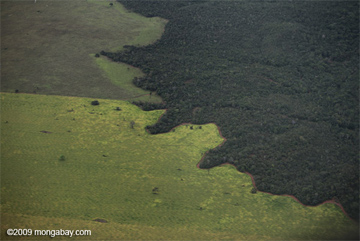|
|
Five to nine percent of the Amazon’s 40,000 known species of plants will be at risk of extinction by 2050 should current deforestation trends continue, report researchers writing in the Proceedings of the National Academy of Sciences. The estimates are sharply lower than the 20 to 33 percent predicted in other studies.
Kenneth J. Feeley and Miles R. Silman of Wake Forest University used plant collections data and ecoregions maps to generate spatially explicit distributions for 40,027 species representing roughly 80% of the 50,000 plant species thought to live in the Amazon. They found that under a “business-as-usual” scenario where 12-24 percent of the Amazon was destroyed by 2050, only five to nine percent of plant species would become “committed to extinction” by mid-century.
 Percentage of habitat area predicted to be lost by 2050 per each of the 96 ecoregions inhabited by Amazonian plant species under the (A) “Business-As-Usual” and (B) “Governance” land-use change scenarios. Image and caption courtesy of PNAS. |
The authors write that unlike other studies, which anticipate higher rates of species loss using a smaller sample of plant species, their work found “the primary determinant of habitat loss and extinction risk is not the size of a species’ range but rather its location.”
-
Several notable studies have estimated extinction risks for
Amazonian plants attributable to habitat loss. These
estimates have almost all been based the documented or predicted
changes in habitat area across the entire Amazon Basin or
other comparably large regions, thereby omitting the
influence of spatial patterns in species ranges and/or disturbances.
By not incorporating information about the location or
size of species ranges or any spatial patterns in the rates of
habitat loss, the resulting extinction estimates are potentially
inaccurate. Furthermore, these methods do not allow extinction
risks to be calculated for individual species.
Feeley and Silman say their methodology more precisely maps species’ potential ranges, thereby helping better anticipate the future impact of habitat loss.
“[Our] estimates are a valuable conservation tool as they indicate not only on the total percentage of Amazonian plant species threatened with extinction, but also the degree to which individual species and habitats will be affected by current and future land-use changes,” they write.
 Cerrado species face greatest extinction risk The model shows that species found in the cerrado ecosystem — a woody grassland and forest transition zone — face the highest risk of extinction due to forecast loss in habitat. With cerrado habitat declining at more than 3 percent annually, cerrado species face twice the extinction risk as non-cerrado species. |
But while the results offer more optimistic outlook for plant biodiversity compared to other studies, Feeley and Silman caution that their model does not include climate change, which could potentially trigger substantial habitat shifts in parts of the Amazon. Nor do their estimates include the potential effects of “synergistic human disturbances or disruptions of biological interactions,” both of which could adversely impact the region’s flora.
“Although the number of threatened species is less than estimated in some previous studies, we stress that ongoing and future land-use changes pose serious threats to Amazonian biodiversity. If the risk estimates
from this study are applied to the 50,000 total vascular plant species (12,500 canopy trees) estimated to occur in the Amazon Basin, we predict that between 2,400 and 4,550 species (600–1,138 species of trees) will become committed to extinction over the next several decades because of land-use change alone,” they write. “This is an unacceptable loss rate and calls for strong and immediate conservation actions.”
Kenneth J. Feeley and Miles R. Silman. Extinction risks of Amazonian plant species. PNAS Early Edition 6 July 2009. http://www.pnas.org/cgi-doi/10.1073/pnas.0900698106